by Lisha Vidler
(Click any photo to view a larger image.)
In this two-part article, we’re taking an up-close look at the costumes displayed at the touring exhibit for Andrew Lloyd Webber’s The Phantom of the Opera. We’ve already seen the Footman’s livery, a slave dancer’s costume, and Piangi’s Hannibal armor. Now let’s examine the Phantom’s suit and cloak, Christine’s Aminta dress, and Carlotta’s silver and black bustle dress from “Prima Donna.”
-
A Note on the Photos
Every picture in this article is protected under US copyright law and cannot be used without permission. You may save them for personal use and research, but you may not publish them anywhere—that includes your website or blog. If you want to share the pictures with others, please give out the link to this article.
WordPress has a file size limit, so all the photos displayed in this article are scaled down. If you would like to see the full-sized photos, contact me and briefly explain why you need the pictures. So long as you promise not to violate my copyright by publishing the images, I’ll send you a zip file containing all of the original photos.
The Phantom’s Suit & Cloak
This formal Victorian evening suit is worn by the Phantom throughout most of the show. When he brings Christine down to his lair for the first time, he dons a magnificent cloak made of black jacquard lined with silvery-gray silk. This costume is normally worn with the Phantom’s iconic fedora. (See the original costume sketch here.)
The costume consists of a gentleman’s tailcoat, waistcoat, shirt, and trousers, plus the opera cloak. Unfortunately, most of the suit was covered by the cloak, so I was unable to get a close look at it.
- Tailcoat, Waistcoat, Shirt, & Trousers
The shirt is white, with vertical pintucks down the front, and faceted jet buttons. Interestingly, the tailcoat and trousers are made of a diamond-textured black silk. The waistcoat has shawl lapels, and fastens with large black buttons with a basket-weave design.
- Cloak
The cloak is a smooth silk, with a black velvet collar. The collar, shoulders, and upper back are covered with beaded appliques. The applique design can vary between productions, and even between the Phantom and his body double. (I’ve seen floral patterns, Baroque scrollwork, and even geometric styles.) This version has floral appliques on the collar and shoulders, and an almost Art Nouveau design on the upper back.
Christine’s Aminta Dress: “Point of No Return”
This ruffled dress is worn by Christine during her smoldering performance of “Point of No Return.” During this scene, she’s playing the role of Aminta in the Phantom’s opera, Don Juan Triumphant, although the placard describing the costume gives the character’s name as “Zerlina.” Apparently, this was a detail changed later on.
The costume is worn with black Victorian button boots and an embroidered shawl. Many have wondered about the exact material this dress is made out of—it’s peach silk taffeta. (See the original costume sketch here.)
The dress is vaguely 18th century in style, having a skirt that’s wider on the sides, as well as a zone-front bodice with an embellished stomacher. There are many variations in the design of this costume, but this one is definitely American. Only in the US does it have a black fichu draped around the neckline. (The design used in the current tour is based off the London version, as seen here.)
The fichu is decorated with colorful floral embroidery and beaded fringe. The fichu’s embroidery appears to be identical to that seen on the shawl Christine wears when she first walks onstage in this costume. Sadly, the shawl was not part of the exhibit. (Although it can be seen here.)
The back of the dress is where it fastens—in this case, with a large zipper. The zipper pull has a ribbon loop attached to it, making it easier to unzip in a hurry. (Other versions use Velcro down the back.)
- Bodice
In London, this costume is made with the skirt and bodice joined as one piece (as seen here), but the American version uses a separate jacket and skirt.
It has a zone-front, which is a diagonal cutaway that leaves the center of the bodice open. The gap is filled with a stomacher. The edges of the cutaway are scalloped and embroidered to match the skirt’s ruffles—an uncommon, but quite lovely feature. You can see that the embroidery was impeccably planned, so it forms a complete motif in the corner and doesn’t get caught in the seams.
When I walked behind the costume, I discovered the most delectable detail on the bodice’s peplum. It has box pleats that spread open over the skirt, and each pleat is lined with a different brocade or jacquard fabric. What a lovely touch!
- Stomacher
The stomacher comes in many variations, but in this example, it has two different brocade fabrics for the background. The outer sections are black with small red, green, and white flowers, while the center panel is black with large red, silver, and lavender flowers. It has faded red piping around the edges and red crisscross lacing down the middle. Buttons of silver and black edge the center panel.
The bottom of the stomacher comes to three points, with the middle point being curved, like an upside-down teardrop. A pink appliqued rose adorns each of the side points, while a cluster of blue roses sits at the center point. (Something seems off about the blue appliques. They appear tacked on, as if they were perhaps added to hide a flaw. It’s also unusual for the pink appliques to be half-hidden by the bodice. It’s almost as if the stomacher belongs to a different costume!)
- Sleeves
The sleeves fall straight to the elbow, where they attach to a gathered ruffle cuff that’s shorter in front and longer in back. The edges of each ruffle are scalloped and embroidered to match the skirt’s ruffles. Underneath is another ruffle of gathered black lace. On the outside, where the cuff is sewn to the sleeve, there’s a delicate black floral trim—although it appears that, in this case, some of the trim is missing. There’s also a black braid and some beaded fringe going around the sleeve.
At the front of each sleeve, a colorful brocade ribbon is attached in the form of a bow. These bows are black with red, green, blue, and white flowers. The inside of the bow is lined with a dark coral silk, which appears much brighter (and perhaps, therefore, newer) than the rest of the costume.
Interestingly, there is a small flaw on the left sleeve, about the size of a dime, that appears to have been darned.
- Skirt
The main skirt is made up of four tiers of scalloped ruffles, which are embroidered with an intricate scrolled design. Black tulle peeks out from underneath each ruffle, emphasizing the different layers and making them more poofy.
Regrettably, the embroidery on the ruffles means it’s definitely not the original costume from twenty-five years ago, as the exhibit claims. The first version of this costume used black lace to decorate the scalloped ruffles, not embroidery. (As seen here.)
- Underskirt
At the center front, the skirt splits to reveal a panel of gold and black lace. The bottom edge is scalloped.
I suspect the bodice and skirt don’t actually go together, mainly because the skirt has faded to a noticeably lighter shade of peach. It’s in rougher condition, too. The ruffles are dirty, stained, and torn. (It actually broke my heart a little.)
Carlotta’s Silver & Black Dress: “Prima Donna”
This Victorian bustle dress is traditionally worn by Carlotta during the first “Notes” scene and “Prima Donna,” although in the current US Tour, her costumes have been switched and this one is worn during the second “Notes” scene, instead.
It’s quite elaborate, with so many different fabrics and trims that it’s hard to make heads or tails of the different pieces. It didn’t help that the dress on display is lacking a proper bustle, which means the skirt hangs limply on the mannequin, with all the layers collapsed on themselves. Even so, it’s quite lovely. This costume is normally worn with a silver fur stole and a dainty hat. (See the original fashion sketch here.)
- Bodice
The bodice is made of a silver and black baroque damask, embellished with black Venetian lace appliques and jet beads. The bodice hem comes to several points around the hips, which are trimmed with a black and white braid.
Tasseled epaulettes decorate the shoulders, similar to the ones on London’s Aminta dress. Ruffled black and white undersleeves peek out from under three-quarter length sleeves, which are pointed like the bodice hem. The shawl collar is made of a thin black and white paisley fabric and trimmed with heavy black appliques. It gathers into a jabot that’s edged with black and white braid.
The back of the bodice has more Venetian appliques curving along the upper back and shoulders. Down the center back, the bodice is split, with a triangular inset panel of silver and black damask (different from the main bodice fabric). Crisscross lacing runs over this panel, accented with silver buttons along the sides. Tasseled lacing ties dangle down the back of the skirt.
-
Skirt
Most of the skirt is hidden beneath the overskirt, but two rows of gathered flounces wrap around the bottom. These are scalloped, but more pointed than round. The flounces are made of a black fabric with an elaborate silver print. Each flounce is bordered with a dark gray and black striped ruffle, whose edges have been pinked. The seam between the flounce and ruffle is covered with a black and silver picot braid.
- Overskirt
Like several of Maria Björnson’s designs for Phantom, the overskirt consists of a front apron, side drapes, and a waterfall train in the back. The front apron is rounded and made of the same fabric as the skirt, and it has the same ruffled flounce.
The side drapes are squared, but pulled back, so they appear pointed. They’re made of a black jacquard fabric and etched with a silver floral design.
The back of the overskirt forms a waterfall train, which is where the fabric folds back and forth, creating a zigzag effect. The outer fabric is black jacquard, while the under fabric is pale gray with a black floral print. The edges of the black jacquard are etched with the same silver design as the side drapes.
It’s a pity the dress is lacking its bustle. It gives the back a lot more oomph! (As seen here.)
~~*~~
I hope you’ve enjoyed this closeup peek at some of the gorgeous costumes from The Phantom of the Opera!
|
Thank You! I must say a special thanks to Anéa, who took the time to discuss many of the quirky details about the costumes. If you haven’t already, check out her website, which analyzes the various costumes from The Phantom of the Opera: Maria Björnson’s Costume Design. |

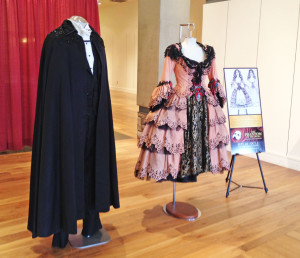
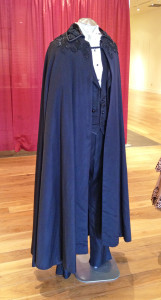
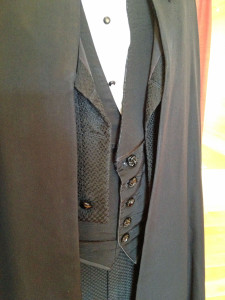
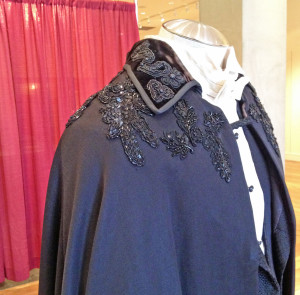
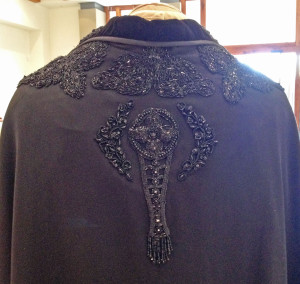
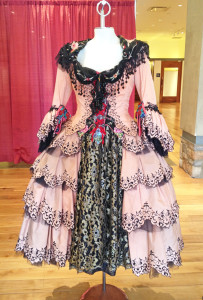
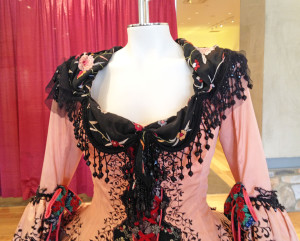
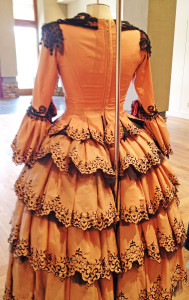
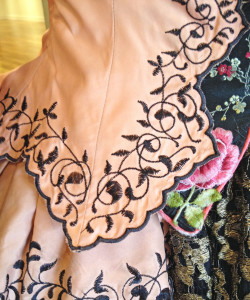
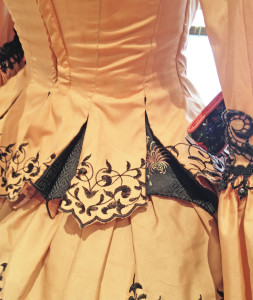
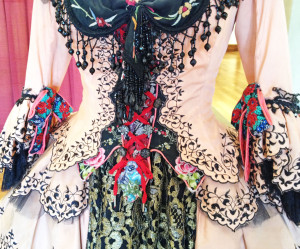
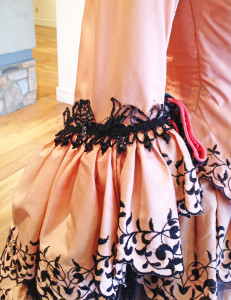
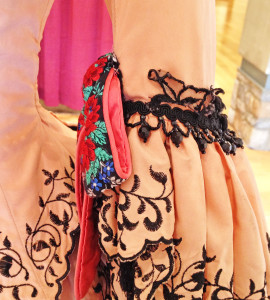
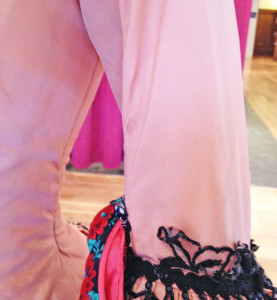
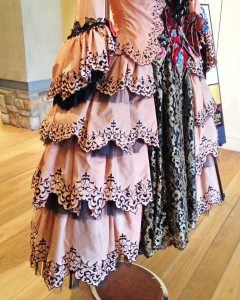
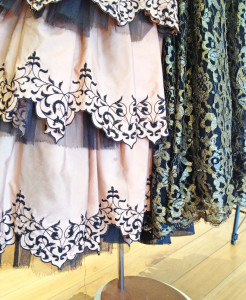
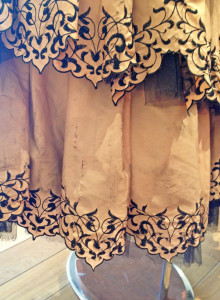
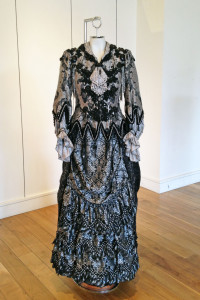
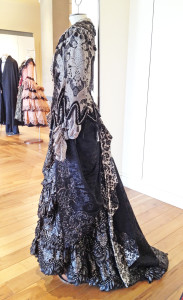
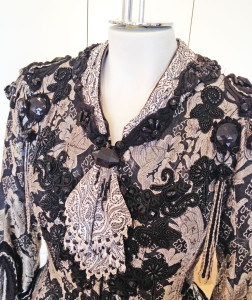
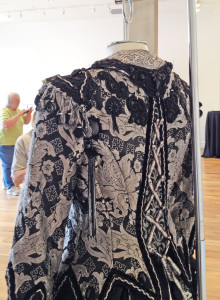
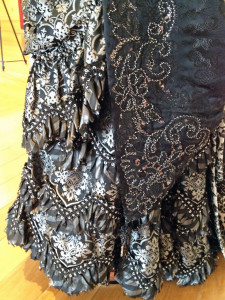
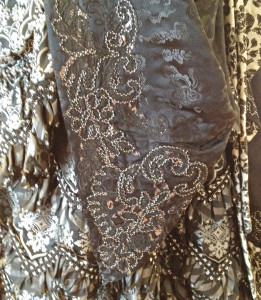
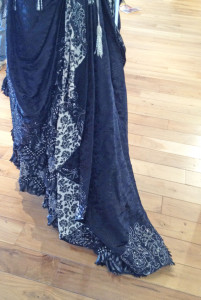
Pingback: The Phantom of the Opera Costume Exhibit | Yesterday's Thimble